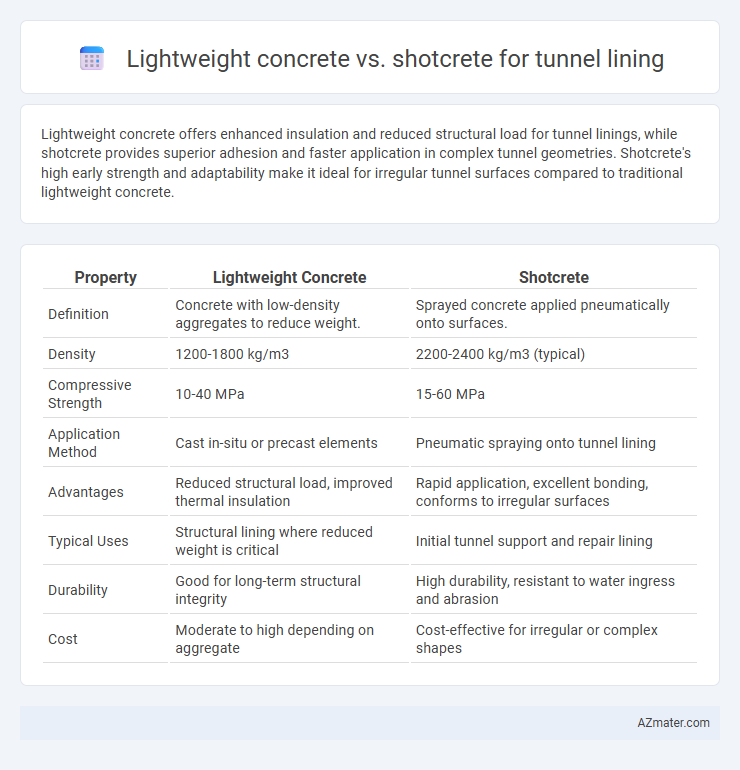Lightweight concrete offers enhanced insulation and reduced structural load for tunnel linings, while shotcrete provides superior adhesion and faster application in complex tunnel geometries. Shotcrete's high early strength and adaptability make it ideal for irregular tunnel surfaces compared to traditional lightweight concrete.
Table of Comparison
| Property | Lightweight Concrete | Shotcrete |
|---|---|---|
| Definition | Concrete with low-density aggregates to reduce weight. | Sprayed concrete applied pneumatically onto surfaces. |
| Density | 1200-1800 kg/m3 | 2200-2400 kg/m3 (typical) |
| Compressive Strength | 10-40 MPa | 15-60 MPa |
| Application Method | Cast in-situ or precast elements | Pneumatic spraying onto tunnel lining |
| Advantages | Reduced structural load, improved thermal insulation | Rapid application, excellent bonding, conforms to irregular surfaces |
| Typical Uses | Structural lining where reduced weight is critical | Initial tunnel support and repair lining |
| Durability | Good for long-term structural integrity | High durability, resistant to water ingress and abrasion |
| Cost | Moderate to high depending on aggregate | Cost-effective for irregular or complex shapes |
Introduction to Tunnel Lining Materials
Lightweight concrete and shotcrete are essential materials in tunnel lining, offering distinct advantages based on project requirements. Lightweight concrete provides reduced dead load and improved thermal insulation, enhancing structural efficiency and durability in underground environments. Shotcrete, applied pneumatically, delivers rapid setting, superior adhesion, and flexibility in complex shapes, making it ideal for irregular tunnel surfaces and immediate support during excavation.
Overview: Lightweight Concrete in Tunnel Construction
Lightweight concrete in tunnel construction offers reduced density and improved thermal insulation compared to traditional materials, enhancing structural efficiency and durability. This material incorporates lightweight aggregates such as expanded clay, shale, or pumice, which lower the overall weight while maintaining sufficient compressive strength for tunnel lining. Its application minimizes load on surrounding strata, reduces excavation demands, and improves fire resistance, making it a preferred choice for modern underground infrastructure projects.
Understanding Shotcrete Applications in Tunneling
Shotcrete, a pneumatically applied concrete, is extensively used for tunnel lining due to its excellent adhesion and adaptability to irregular surfaces, enabling rapid and effective structural support. Lightweight concrete offers reduced density and enhanced thermal insulation but lacks the immediate application benefits and structural bonding properties inherent to shotcrete. Understanding shotcrete's ability to conform to complex tunnel geometries and provide early strength gain is crucial for optimizing tunnel construction and safety.
Key Material Properties: Lightweight Concrete vs Shotcrete
Lightweight concrete for tunnel lining typically exhibits lower density ranging from 1600 to 1920 kg/m3, providing enhanced thermal insulation and reduced dead load compared to conventional concrete. Shotcrete, characterized by its high early strength and excellent bond strength due to pneumatic application, offers superior adhesion and fast setting times crucial for tunnel stability during excavation. Both materials demonstrate varying compressive strengths, with shotcrete generally achieving strengths between 20 to 40 MPa rapidly, while lightweight concrete can be tailored for specific load requirements through mix design adjustments.
Installation Techniques for Tunnel Linings
Lightweight concrete for tunnel lining involves traditional casting methods that require formwork and longer curing times, enabling precise shaping and structural control. Shotcrete application uses pneumatic spraying to rapidly deliver concrete onto surfaces, providing faster installation and better conformity to irregular tunnel geometries. Both techniques demand skilled labor, but shotcrete significantly reduces construction time and minimizes formwork costs compared to lightweight concrete casting.
Structural Performance and Durability Comparison
Lightweight concrete offers reduced density and improved thermal insulation, benefiting tunnel lining by minimizing dead loads and enhancing structural efficiency under static loads. Shotcrete, applied pneumatically, provides excellent adhesion and dense compaction, resulting in superior durability against water ingress and mechanical abrasion within tunnel environments. Structural performance favors shotcrete for complex geometries and rapid reinforcement, while lightweight concrete excels in long-term load distribution and thermal regulation.
Cost Effectiveness and Resource Efficiency
Lightweight concrete reduces material costs and improves thermal insulation in tunnel lining, offering long-term energy savings and easier handling during application. Shotcrete enables rapid placement with minimal formwork, significantly lowering labor expenses and construction time. Resource efficiency in shotcrete is enhanced by reducing cement usage through additives and recycling rebound material, making it a cost-effective solution for complex tunnel geometries.
Environmental Impact and Sustainability
Lightweight concrete used for tunnel lining reduces overall structural weight and limits material consumption, leading to lower embodied carbon emissions compared to traditional shotcrete, which often relies on denser aggregates and higher cement content. Shotcrete's rapid application and reduced formwork needs minimize construction waste and energy use on-site, providing efficiency benefits but potentially higher environmental costs due to cement intensity. Sustainable tunnel lining solutions prioritize optimized mix designs in lightweight concrete to enhance thermal insulation and durability, thereby extending service life and reducing lifecycle environmental impacts compared to conventional shotcrete.
Case Studies: Real-World Tunnel Projects
Case studies of tunnel projects reveal that lightweight concrete enhances tunnel lining by reducing overall structural load and improving thermal insulation, as demonstrated in the Gotthard Base Tunnel, Switzerland. Shotcrete offers rapid application and excellent early strength gain, critical in the New Austrian Tunneling Method (NATM) applied in the Crossrail project, London. Comparative analysis shows shotcrete's adaptability in irregular rock conditions while lightweight concrete excels in long-span tunnels requiring weight optimization.
Conclusion: Choosing the Optimal Tunnel Lining Solution
Lightweight concrete offers advantages in thermal insulation and reduced structural load, making it suitable for tunnels with strict weight constraints. Shotcrete provides excellent adhesion and rapid application, ideal for complex geometries and fast project timelines in tunnel lining. Selecting the optimal solution depends on project-specific factors such as tunnel size, environmental conditions, and construction speed requirements.

Infographic: Lightweight concrete vs Shotcrete for Tunnel lining
 azmater.com
azmater.com